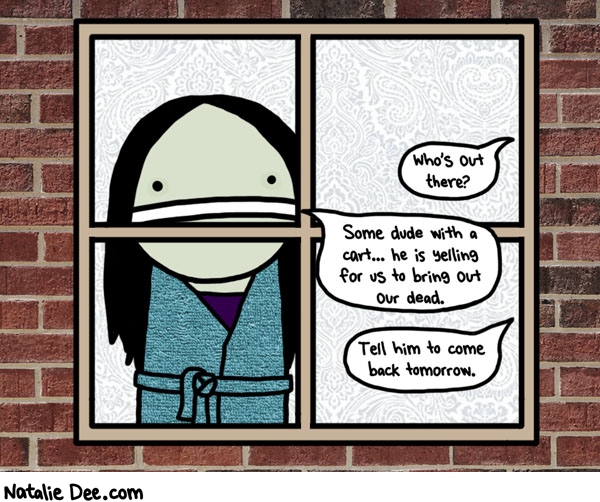Remember when people used to die left and right from curable diseases, simply because we hadn't discovered antibiotics yet?
Of course you don't...that was way back in the middle ages (or thereabouts--I was never much good at history). You know, back when people believed diseases were caused by an imbalance of humours in the body, and/or god sending punishment. Plus nobody really knew that lack of proper sanitation could cause death. So I guess there were other mitigating factors in the high death rate from theoretically curable diseases...but still, lack of antibiotics and other drugs didn't help the matter.
We in the developed world with our fancy medicine and cleanly hospitals like to feel smug because we no longer die from the same horrible diseases as they did in the middle ages, but we aren't actually as protected as we think. I'm sure you have all heard about the controversy about feeding antibiotics to animals, the overperscritpion of antibiotics, and the rise of antibiotic resistant bacteria? Well, that's today's fear-inspiring topic for "We're all gonna die."
Recently, a super-antibiotic-resistant bacteria was found in the water supply in New Delhi. This bacteria is called NDM-1, and not only was it found in the water people drink, not only does it have its own website, but it also has the potential to give its antibiotic resistance to other bacteria! As a reporter for the Guardian writes:
The bacterium was found to be indifferent to even our most powerful antibiotics. To make matters worse, the genes that gave it this superpower were found on a small ring of DNA that is easily traded between different species of bacteria.
New Delhi metallo-beta-lactamase (NDM-1) has since turned up in more than 16 countries across the world, including Britain. A study published in Lancet Infectious Diseases today shows the resistance factor has spread to 14 different species of bacteria, including pathogenic varieties responsible for dysentery and cholera. Most bacteria holding the NDM-1 plasmid are resistant to all but a couple of our most clumsy, brutal antibiotics. One strain is immune to all of them.
This news is quite alarming, and it (along with other similar concerns) has spurred worldwide alarms from the medical community. The World Health Organization made antimicrobial resistance the theme of World Health Day 2011, under the slogan (and I am not making this up, though I am bolding and italicizing it):
Antimicrobial resistance: no action today, no cure tomorrow.
A representative of the WHO posted a Q&A about the topic, and in response to the question "Is this the doomsday scenario of a world without antibiotics?" he answered:
Unfortunately yes, with these new multiresistant NDM1-containing strains and their potential for worldwide spread. Doctors will face a terrible dilemma when a pregnant woman develops a kidney infection that spills over into the bloodstream with a pan-resistant strain containing NDM1 and there are no treatment options. We are essentially back to an era with no antibiotics.
I don't think it's hasty if I say it is TIME TO PANIC!!
Diseases associated with antimicrobial resistance include but are certainly not limited to things like Staph (MRSA), Anthrax(!), Gonorrhea, and of course, Tuberculosis. (Side note: If you're interested in multi-drug resistant TB (and who wouldn't be), this is a really good book.)
A WHO pamphlet released in conjunction with World Health Day 2011 has some fun facts about antimicrobial resistance (AMR):
- About 440,000 new cases of multidrug-resistant tuberculosis (MDR-TB) emerge annually, causing at least 150,000 deaths. Extensively drug-resistant tuberculosis (XDR-TB) has been reported in 64 countries to date.
- Resistance to earlier generation antimalarial medicines such as chloroquine and sulfadoxine-pyrimethamine is widespread in most malaria-endemic countries. Falciparum malaria parasites resistant to artemisinins are emerging in South-East Asia; infections show delayed clearance after the start of treatment (indicating resistance).
- A high percentage of hospital-acquired infections are caused by highly resistant bacteria such as methicillin-resistant Staphylococcus aureus (MRSA) and vancomycin-resistant enterococci.
- Resistance is an emerging concern for treatment of HIV infection, following the rapid expansion in access to antiretroviral medicines in recent years; national surveys are underway to detect and monitor resistance.
- Ciprofloxacin is the only antibiotic currently recommended by WHO for the management of bloody diarrhoea due to Shigella organisms, now that widespread resistance has developed to other previously effective antibiotics. But rapidly increasing prevalence of resistance to ciprofloxacin is reducing the options for safe and efficacious treatment of shigellosis, particularly for children. New antibiotics suitable for oral use are badly needed.
- AMR has become a serious problem for treatment of gonorrhoea (caused by Neisseria gonorrhoeae), involving even “last-line” oral cephalosporins, and is increasing in prevalence worldwide. Untreatable gonococcal infections would result in increased rates of illness and death, thus reversing the gains made in the control of this sexually transmitted infection.
- New resistance mechanisms, such as the beta-lactamase NDM-1, have emerged among several gram-negative bacilli. This can render powerful antibiotics, which are often the last defence against multi-resistant strains of bacteria, ineffective.
Just in case you didn't read through all of that dense text, the fun facts indicate that we may no longer be able to cure malaria, staphylococcus infections, bloody diarrhea, gonorrhea, and NDM-1 infections.
As the WHO notes, complacency kills. I think I'll leave you with that.


1) possibly the funniest part of this post: "...and I am not making this up, though I am bolding and italicizing it):
ReplyDeleteAntimicrobial resistance: no action today, no cure tomorrow."
2) possibly the scariest part: all the other words.
I need some solutions, blog author. What can we do to protect ourselves from the microbes!?!?
This isn't a blog about solutions, It's a blog about problems. But If you need a ray of hope, the WHO does have a six-point plan to combat the spread of AMR. I suppose you could help make those things happen.
ReplyDelete